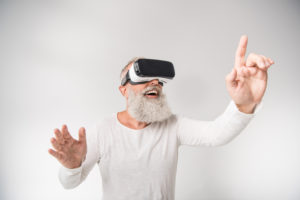 If you are at all curious about the future, one of the best futurist blogs to subscribe to is Peter Diamandis’ Tech Blog. While he tends to approach his enthusiasm for future technology through the lens of capitalism, I do find his writing often piquing my curiosity.
If you are at all curious about the future, one of the best futurist blogs to subscribe to is Peter Diamandis’ Tech Blog. While he tends to approach his enthusiasm for future technology through the lens of capitalism, I do find his writing often piquing my curiosity.
Recently, he published a blog titled, VR’s Leap into the Disruptive Phase. The section I found most applicable to my work was the section Future of VR: Emotive and Immersive Education:
History class, 2030. This week’s lesson: Ancient Egypt. The pharaohs, the queens, the tombs—the full Tut.
Sure, you’d love to see the pyramids in person. But the cost of airfare? Hotel rooms for the entire class? Plus, taking two weeks off from school for the trip? None of these things are doable. Worse, even if you could go, you couldn’t go. Many of Egypt’s tombs are closed for repairs, and definitely off-limits to a group of teenagers.
Not to worry, VR solves these problems. And in VR world, you and your classmates can easily breach Queen Nefertari’s burial chamber, touch the hieroglyphics, even scramble atop her sarcophagus—impossible opportunities in physical reality. You also have a world-class Egyptologist as your guide.
But turning your attention to the back of the tomb doesn’t require waiting until 2030. In 2018, Philip Rosedale and his team at High Fidelity pulled off this exact virtual field trip.
First, they 3D-laser scanned every square inch of Queen Nefertari’s tomb. Next, they shot thousands of high resolution photos of the burial chamber. By stitching together more than ten thousand photos into a single vista, then laying that vista atop their 3D-scanned map, Rosedale created a stunningly accurate virtual tomb. Next, he gave a classroom full of kids HTC Vive VR headsets.
Because High Fidelity is a social VR platform, meaning multiple people can share the same virtual space at the same time, the entire class was able to explore that tomb together. In total, their fully immersive field trip to Egypt required zero travel time, zero travel expenses.
VR will not only cover traditional educational content, but also expand our emotional education.
Jeremy Bailenson, founding director of Stanford’s Virtual Human Interaction Lab, has spent two decades exploring VR’s ability to produce real behavioral change. He’s developed first-person VR experiences of racism, sexism, and other forms of discrimination.
For example, experiencing what it would be like to be an elderly, homeless, African American woman living on the streets of Baltimore produces real change: A significant shift in empathy and understanding.
“Virtual reality is not a media experience,” explains Bailenson. “When it’s done well, it’s an actual experience. In general our findings show that VR causes more behavior changes, causes more engagement, causes more influence than other types of traditional media.”
Nor is empathy the only emotion VR appears capable of training. In research conducted at USC, psychologist Skip Rizzo has had considerable success using virtual reality to treat PTSD in soldiers. Other scientists have extended this to the full range of anxiety disorders.
VR, especially when combined with AI, has the potential to facilitate a top shelf traditional education, plus all the empathy and emotional skills that traditional education has long been lacking.
When AI and VR converge with wireless 5G networks, our global education problem moves from the nearly impossible challenge of finding teachers and funding schools for the hundreds of millions in need, to the much more manageable puzzle of building a fantastic digital education system that we can give away for free to anyone with a headset. It’s quality and quantity on demand.
In the workplace, VR will serve as an efficient trainer for new employees.
10,000 of Walmart’s 1.2 million employees have taken VR-based skills management tests. Learning modules that once took 35 to 45 minutes, now take 3 to 5. The company plans to train 1 million employees using the Oculus VR headset by the end of this year. The upfront costs of VR headsets will ultimately be recovered in labor efficiencies.
At face value, it sounds like VR has some real potential in the design of never-before-experienced learning opportunities! A curiosity emerged from this reading pertaining to arguably the greatest challenge of the shift to learner-centered education: shifting mindsets.
Will VR be able to serve the work of enrolling others into the learner-centered paradigm by actually engaging empathy through the senses? Will we be able to use VR to place people, particularly educators, in different kinds of learning environments so they can feel the boredom and drudgery of school-centered models? Will we be able to use VR to contrast a school-centered model with the exhilarating experience of living in a learner-centered model? Could we possibly harness VR and its capabilities to generate empathy to help accelerate the critical mindset shift?
What are your curiosities for harnessing VR in a learner-centered environment?
Connect with Randy on Twitter, the TLTalkRadio podcast, and the Shift Your Paradigm podcast!
Get new content delivered to your inbox and the ebook 3 Key Principles of Digital Transformation. The ebook contains valuable information from my experience leading a digital transformation and working with a variety of stakeholders over the past decade.
- A silver lining - January 22, 2022
- Is our use of tech working against us? 🤔 - September 8, 2021
- What’s NOT going to change in the next 10 years? 🤔 - September 7, 2021